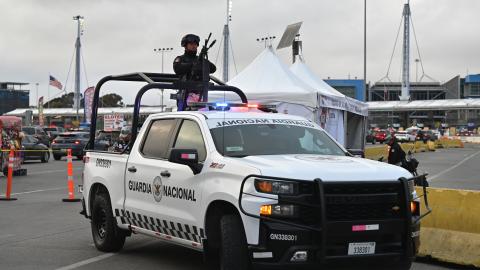In Davos in 2017, Xi Jinping painted a vision of a China-led globalist world. The Chinese Communist Party's handling of the COVID-19 pandemic gives us a taste of Chinese global leadership: it includes a breathtaking degree to which other nations, desperate for transparency and reciprocity in the form of detailed information and medical supplies, have been left in a lurch, and therefore vulnerable to Chinese coercion. This is not an opportunity for cooperation with China. This is not a moment for a reprieve in America's competition against the communist regime; it is a harrowing foreshadowing of what is at stake if we lose.
Competition with China spans the spheres of economics and diplomacy, but undergirding the entire effort is American hard power. It is our military, both our military capabilities as well as our willingness to employ them, that keeps Chinese territorial expansion at bay. And even during a global pandemic of Beijing’s making, Beijing’s military has been very busy. It is why the United States must follow through with the Pentagon’s plans to recapitalize our strategic deterrent and other military plans meant to deter Chinese aggression.
The COVID-19 pandemic has prompted the United States and its partners to pause wargaming exercises that are meant to reassure allies and bolster readiness to protect the health of its military members. In contrast, China has not slowed down provocative, offensive military maneuvers. Beijing just days ago conducted naval drills near Taiwan’s shores, has continued to buzz Taiwan’s airspace, it sank a Vietnamese fishing vessel in international waters, and according to State Department spokesperson Morgan Ortagus, the Chinese government has continued to make developments on military bases China built on reefs and islands on which it erroneously claims sovereignty.
Defense officials have repeatedly warned that the first island chain is vulnerable to Chinese aggression. Nested in that first island chain are Taiwan and Japan, valuable allies, and who will be critical allies in the U.S. effort to weaken China’s leverage and expose its malign behavior. They are among others in the larger Indo-Pacific region to include India and Australia that will anchor our cooperative efforts to defend national sovereignty against CCP authoritarianism.
Defense Secretary Mark Esper has said the Pentagon is committed to mission readiness during the pandemic. He also told Congress in February that the “highest priority remains China, as its government continues to use — and misuse — its diplomatic, economic and military strength to attempt to alter the landscape of power and reshape the world in its favor, often at the expense of others.”
While deterring China and assuring allies entails much more than our strategic deterrent, the cornerstone for deterring military aggression of the worst kind is our nuclear arsenal. The nuclear modernization strategy laid out in the Trump Nuclear Posture Review must continue to move forward on time, and the COVID-19 pandemic cannot be a pretext for delays.
The cost of the entire nuclear enterprise is roughly 5 percent of all national security spending devoted to the recapitalization, sustainment, and operations. The Obama administration began the modernization effort, and the Trump administration has determined to carry it through while adapting it based on the actions of China as well as Russia.
Defense officials have warned that in addition to Russia, China presents formidable nuclear challenges, and the trends are not headed in the right direction. Although China refuses to be transparent about its nuclear program, the United States knows China has significant capabilities that leverage cutting edge technology and assesses China is likely to at least double the size of its nuclear arsenal by the end of the decade. Additionally, China's nuclear weapons are central to China's military plans and intentions.
Despite the significant continuity between administrations about nuclear modernization, there will be efforts to cancel or delay some components of the force, and dealing with pandemics will be used as a pretext. For years, ideologically motivated groups have focused on the intercontinental ballistic missiles, or "land-based leg" of the triad, specifically, as an opportunity to find financial savings. Some have argued against eliminating the leg altogether while some argue it makes more sense to continue to extend the life of the current fleet, the old Minuteman IIIs with Cold War era technologies, rather than pursue its replacement called the Ground-based Strategic Deterrent (GBSD). But military leaders have repeatedly warned that the decades' old Minuteman IIIs would have trouble penetrating future air defenses, and the cost to pursue GBSD will not be more expensive than another life extension program that would leave the United States underprepared. Now is not the time to delay the next generation of our nuclear weapons.
Conventional weapons are also necessary to deter Chinese aggression. Remember, the aim is to deter the aggression in the first place, rather than respond once China decides to act on its malign intention to attack U.S. bases or territory of a sovereign nation. The United States can do this if it convinces Beijing it has the will and capability to retaliate defensively in response to an offensive act of aggression such that Beijing will regret the decision.
So, in addition to the nuclear program, there are meaningful changes underway. For example, the U.S. Marine Corps is focused on deploying a force in the Indo Pacific theater in cooperation with our allies, which is inside the range of China's massive missile force. This force would be so formidable and with so many targets distributed throughout the region that it allows the U.S. military a high degree of resiliency. The USMC also wants offensive long-range missiles, drones, and rocket artillery, and lots of them. Notable, now that President Trump withdrew from the dated INF Treaty due to Russian cheating, the USMC can have the range of missiles it needs. The United States will also need a mix of defensive systems with the ability to intercept the first rounds of missile attacks to preserve the U.S. ability to respond and with more options at its disposal. This offense-defense mix that includes passive and active defenses will complicate Beijing's calculations and will dissuade an initial move and preserve peace.
The current COVID-19 pandemic will impact all areas of the U.S. government and reshuffle initiatives and divide attention. But it's vital to appreciate the severity of China's actions, that China is the cause of this historic crisis, and that its military is exploiting it to gain an advantage over the United States in the near and long term. The United States must work to ensure they fail.
Read in RealClear Defense


















